
Artemisia is a large, diverse genus of plants belonging to the daisy family Asteraceae, with between 200 and 400 species. Common names for various species in the genus include mugwort, wormwood, and sagebrush.

Artemisia vulgaris, the common mugwort, is a species of flowering plant in the daisy family Asteraceae. It is one of several species in the genus Artemisia commonly known as mugwort, although Artemisia vulgaris is the species most often called mugwort. It is also occasionally known as riverside wormwood, felon herb, chrysanthemum weed, wild wormwood, old Uncle Henry, sailor's tobacco, naughty man, old man, or St. John's plant. Mugworts have been used medicinally and as culinary herbs.
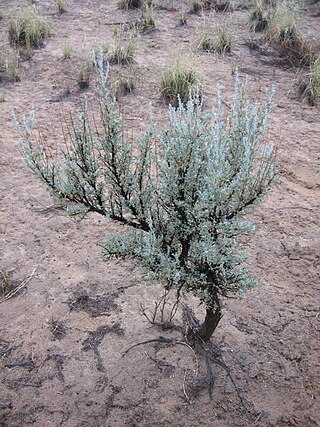
Artemisia tridentata, commonly called big sagebrush, Great Basin sagebrush or (locally) simply sagebrush, is an aromatic shrub from the family Asteraceae, which grows in arid and semi-arid conditions, throughout a range of cold desert, steppe, and mountain habitats in the Intermountain West of North America. The vernacular name "sagebrush" is also used for several related members of the genus Artemisia, such as California sagebrush.

Iris douglasiana, the Douglas iris, is a common wildflower of the coastal regions of Northern and Central California and southern Oregon in the United States. It grows mainly at lower elevations, below 100 meters (330 ft), though it is occasionally found at heights of up to 1,000 meters (3,300 ft). It is most common in grasslands near the coast.
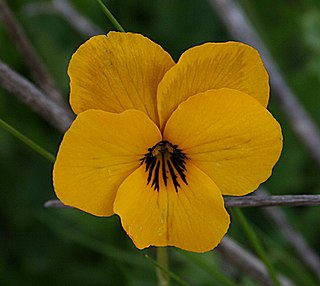
Viola pedunculata, the California golden violet, Johnny jump up, or yellow pansy, is a perennial yellow wildflower of the coast and coastal ranges in California and northwestern Baja California. The common name "Johnny jump up" is usually associated with Viola tricolor however, the introduced garden annual.

Rubus parviflorus, commonly called thimbleberry, is a species of Rubus native to northern temperate regions of North America. The plant has large hairy leaves and no thorns. It bears edible red fruit similar in appearance to a raspberry, but shorter, almost hemispherical. It has not been commercially developed for the retail berry market, but is cultivated for landscapes.

Spiraea douglasii is a species of flowering plant in the rose family native to western North America. Common names include hardhack,hardhack steeplebush, Douglas' spirea, douglasspirea, steeplebush, and rose spirea.

Ambrosia artemisiifolia, with the common names common ragweed, annual ragweed, and low ragweed, is a species of the genus Ambrosia native to regions of the Americas.
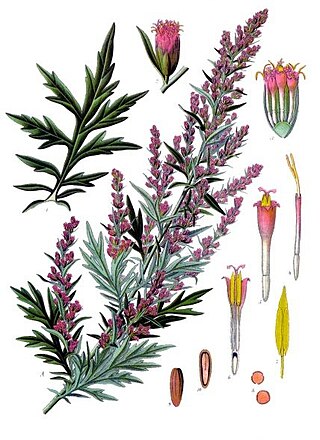
Mugwort or biboz is a common name for several species of aromatic flowering plants in the genus Artemisia. In Europe, mugwort most often refers to the species Artemisia vulgaris, or common mugwort. In East Asia the species Artemisia argyi is often called "Chinese mugwort" in the context of traditional Chinese medicine, Ngai Chou in Cantonese or àicǎo (艾草) in Mandarin. Artemisia princeps is a mugwort known in Korea as ssuk (쑥) and in Japan as yomogi (ヨモギ). While other species are sometimes referred to by more specific common names, they may be called simply "mugwort" in many contexts.

Rosa nutkana, the Nootka rose, bristly rose, or wild rose is a 0.6–3.0-metre-tall (2–10-foot) perennial shrub in the rose family (Rosaceae).

Artemisia pycnocephala is a North American species of sagebrush in the sunflower family, known by the common names beach wormwood, sandhill sage, and coastal sagewort.
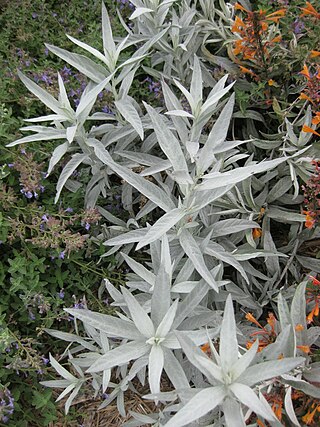
Artemisia ludoviciana is a North American species of flowering plant in the daisy family Asteraceae, known by several common names, including silver wormwood, western mugwort, Louisiana wormwood, white sagebrush, lobed cud-weed, prairie sage, and gray sagewort.

Artemisia michauxiana is a North American species of wormwood in the sunflower family. It is known by the common names Michaux's wormwood and lemon sagewort. It is native to the western United States and Canada. It grows in mountain talus habitats in subalpine to alpine climates.

Artemisia palmeri is a rare species of sagebrush known by the common names San Diego sagewort and Palmer sagewort.
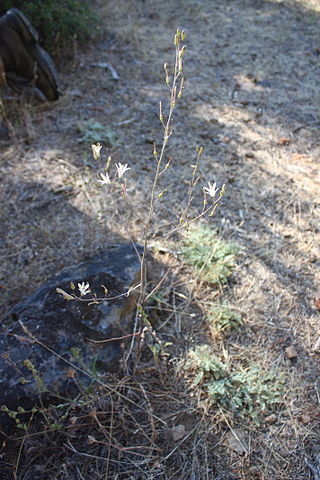
Chlorogalum angustifolium is a species of flowering plant, known by the common name narrowleaf soap plant.

Diplacus douglasii is a species of monkeyflower known by the common names brownies and purple mouse ears. It is native to the mountains and foothills of California and Oregon, where it is often found on serpentine soils. D. douglasii was first described in a published flora by George Bentham, an English botanist who was considered "the premier systematic botanist of the nineteenth century,." It was later described by Asa Gray, the father of North American botany.

Mentzelia multiflora, commonly known as Adonis blazingstar, Adonis stickleaf, desert blazingstar, prairie stickleaf and manyflowered mentzelia is a herbaceous perennial wildflower of the family Loasaceae.

Artemisia norvegica is a species of flowering plant in the aster family known by the common names alpine sagewort, boreal sagewort, mountain sagewort, Norwegian mugwort, arctic wormwood, and spruce wormwood. It is found in cold locations in Eurasia and high altitudes and high latitudes in North America.
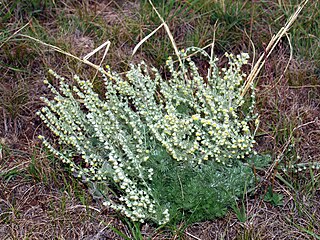
Artemisia frigida is a widespread species of flowering plant in the aster family, which is known as the sunflower family. It is native to Europe, Asia, and much of North America. In parts of the north-central and northeastern United States it is an introduced species.
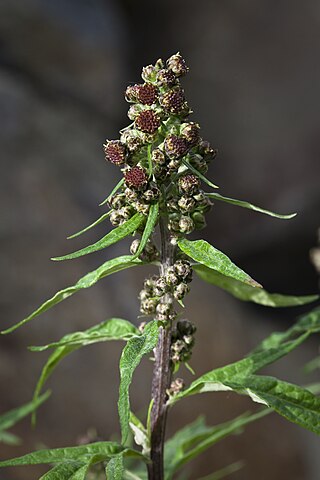
Artemisia tilesii is an Asian and North American species of flowering plant in the aster family. Its common names include Tilesius' wormwood, Aleutian mugwort, and stinkweed. It is native to Russia, Japan, and northern North America.






















